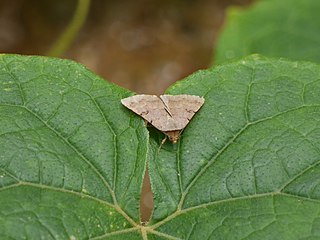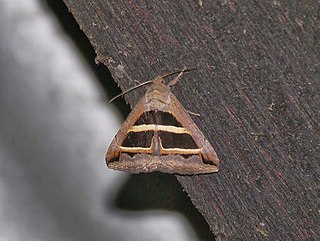
Celtis is a genus of about 60–70 species of deciduous trees, commonly known as hackberries or nettle trees, widespread in warm temperate regions of the Northern Hemisphere, in southern Europe, southern and eastern Asia, and southern and central North America, south to central Africa, and northern and central South America. The genus is present in the fossil record at least since the Miocene of Europe, and Paleocene of North America and eastern Asia.
Tarachephia is a monotypic moth genus of the family Noctuidae erected by George Hampson in 1926. Its only species, Tarachephia hueberi, was first described by Nikolay Grigoryevich Erschoff in 1874. It is found in Turkestan. It is found in Syria, Iraq, Iran, the Transcaspian Region, Uzbekistan, Turkmenistan, Afghanistan and Israel.
Rivula tanitalis is a species of moth of the family Noctuidae first described by Hans Rebel in 1912. It is found in Morocco, Egypt, Algeria, Malta, Crete, Greece, Lebanon, Iraq, Iran, Saudi Arabia, Yemen and Israel.
Zethes insularis is a species of moth in the family Erebidae first described by Jules Pierre Rambur in 1833. The species is found in the warmer parts of the Mediterranean area: Armenia and the Caucasus, Iraq, south-western Iran, Lebanon, Israel, Syria and Jordan.

Plecoptera reflexa is a species of moth of the family Noctuidae first described by Achille Guenée in 1852. It is mainly found in India, but its range extends west as far as the central and northern parts of the coastal plains of Israel.
Plecoptera inquinata is a species of moth of the family Noctuidae first described by Julius Lederer in 1857. It is found in Turkey, Azerbaijan, Iran, Lebanon and Israel.
Autophila limbata is a moth of the family Noctuidae first described by Otto Staudinger in 1871. It is found in southern France, southern Italy, the Iberian Peninsula, Greece, the Crimea, the Near East, Iran, Transcaucasia and Turkmenistan.

Lygephila lusoria is a moth of the family Erebidae. The species was first described by Carl Linnaeus in his 1758 10th edition of Systema Naturae. It is found in southern Europe, the Near East and Middle East, European south-eastern Russia, the Caucasus, Turkey and Israel.
Iranada turcorum is a moth of the family Noctuidae first described by Hans Zerny in 1915. It is found in Syria, Lebanon, Israel, Jordan, Egypt, Iraq, Oman and south-western Iran.

Catocala puerpera is a moth of the family Erebidae first described by Michel-Esprit Giorna in 1791. It is found in Mediterranean and sub-Mediterranean areas of the Near East and Middle East and in North Africa.

Ulotrichopus tinctipennis is a moth of the family Noctuidae first described by George Hampson in 1902. It is found in Botswana, Burkina Faso, Djibouti, Egypt, Ethiopia, Kenya, Mauritania, Namibia, Nigeria, Oman, Saudi Arabia, Somalia, Sudan, Eswatini, Tanzania, United Arab Emirates, Yemen, Zimbabwe, Israel and Jordan.
Clytie syriaca is a moth of the family Erebidae first described by Charles-Juste Bugnion in 1837. It is found along the coastal regions of the Mediterranean Basin, from the Balkans to Turkey, Lebanon, Syria and Israel.
Dysgonia rogenhoferi is a moth of the family Noctuidae first described by Otto Bohatsch in 1880. It is found in Lebanon, Israel, Iraq, Arabia, Turkmenistan, northern Iran, Uzbekistan, the European part of southern Russia, Azerbaijan and Pakistan.

Grammodes boisdeffrii is a moth of the family Noctuidae first described by Charles Oberthür in 1867. It is found from the northern and western parts of the Sahara to Egypt, Israel and Lebanon.

Grammodes bifasciata is a moth of the family Erebidae first described by Vincenzo Petagna in 1787. It is found in Madagascar, eastern Africa, North Africa and other parts of the Mediterranean Basin, including south of France and Israel.
Anumeta hilgerti is a moth of the family Noctuidae first described by Rothschild in 1909. It is found from Morocco to the Arabian Peninsula.
Pericyma squalens is a moth of the family Noctuidae first described by Julius Lederer in 1855. It is found in south-eastern Turkey, Iran, Iraq, Afghanistan, Turkmenistan, Kuwait, Saudi Arabia, Egypt, Lebanon, Israel and Jordan.
Heteropalpia profesta is a moth of the family Noctuidae first described by Hugo Theodor Christoph in 1887. It is found in the Near East, the Middle East, Iraq, Iran, Afghanistan, Transcaucasia, Turkmenistan and the Arabian Peninsula.
Tytroca leucoptera is a moth of the family Noctuidae first described by George Hampson in 1896. It is found in the Arabian Peninsula and all deserts of North Africa.
Gnamptonyx innexa is a species of moth in the family Erebidae first described by Francis Walker in 1858. The species is found from Morocco to the Arabian Peninsula, Israel, Iran, Afghanistan, Pakistan and western India.




